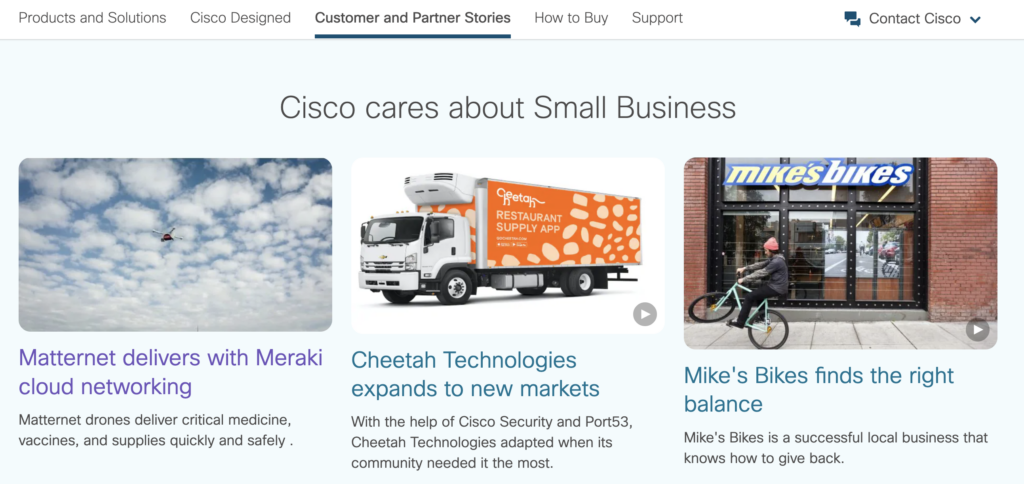Why successful B2B technology companies are investing in customer success stories – and how you can too
Customer success stories are used by B2B marketers, particularly in the technology sector, to reassure new customers that their solution, and process of working together solves their problems, by demonstrating it has done it before.
This is important in earning trust before a transaction and cements the relationship with the customer in the story as it showcases them too. Placing them in the spotlight enables them to educate their peers and share their thought leadership. This is more likely to enhance their loyalty to you in the long run (great for your business) and their advocacy of you in the future (great for your growth).
Velo has developed award winning programmes for a number of clients that have drawn on using customer success stories in marketing communications.
So, in this post, we’re going to unpack our thinking about using customer success stories in your marketing.
Why use customer success stories?
There are a number of reasons why using customer success stories are not just good, but essential to growing your business. Here’s three.
1. Stand out from competition. Sometimes it’s difficult to communicate how your business is different. You can make your claims, but if another customer guarantees that it works for them, it dissolves any concern would-be customers might face. Real live experience helps convince more potential customers to take the leap.
2. Encourage customer loyalty. It’s a hectic world. By asking costumes to share their opinions and experiences, you not only remind them of your brand but also let them know that you care about what they have to say. Naturally, customers feel more loyal to businesses that treat them like actual people who should be heard.
3. Overcoming cynicism. With so many products being promoted daily across many channels, it’s in human nature now to be skeptical and cynical. Everyone is busy, so we don’t have the time to consider most of the marketing we see. That means there is a “yeah right, prove it” attitude that you’ll need to confront. And the most powerful and efficient way to do that is through customer stories.
The importance of creating a process and a structure for customer success stories
The first challenge lies in finding the right customer to create a story around and use in your marketing. Ideally, you want to choose someone who a big chunk of your own target audience will identify with. The objective is to use their experience to encourage others to make contact.
How do you shortlist customers for success stories
- Look for a customer with a unique pain point that your company was able to solve. Be sure to toe the line between unique and complicated, though—you want to be sure the issue resonates with other businesses.
- The more involved they are with you to begin with, the more likely they’ll be to give you the details that will make the story pop. So go for a responsive customer.
- Start with customers that have worked with you for a reasonable amount of time or returning customers who can speak about more than just one transaction.
What is the best structure for a customer success story?
The best structure to adopt for a high impact customer success story is the following format.
1. Set up. Some background to the customer in terms of size, markets and operations.
2. Challenge. The specific challenges the customer was facing when they approached you.
3. Methodology [Optional] The diagnostic process you went through to establish the right solution.
4. Tranformation. How your product/service helped them reach their goals or tackle their pain points
5. Results. The specific benefits and outcomes from using your product/service.
6. Testimonial comment/s. Use a standalone quote to reinforce the points made about the product and service – unless the piece is written totally from the customer perspective.
A structure is important because you need to ensure the story speaks to the audience you want to influence and that it covers the critical before, during and after stages of your involvement.
Ideally any customer success story, however it is designed and delivered, should contain a call to action that aims to build on their potential interest. This might lead them to a more expansive download with more insights, a demonstration, a free trial, Live Chat or an immediate call back.
How to implement customer success stories into your marketing
Once developed, customer success stories can be used right across your marketing.
Cisco might host these short videos on a dedicated solutions for small business page on their website, but they will also feature extensively on their social media channels, be used in email at trade shows and events and even in building reception areas.

With the emergence of micro-content, customer success stories when recorded as video (or audio) can be chopped up into short clips, static images and quotes to be used to encourage potential customers to click and visit the site for more information.
That same content can be used to structure email campaigns and audio (podcast) content.
If they are written in long form and made available as web pages, they can be used as reference points in Live Chat and in follow up on discovery calls.
They could be featured in blog and FAQ sections of websites to maximise the way website visitors can find them.
As we mentioned, we used our customer success work with Sage Champions to gain media exposure and shortlisting for marketing effectiveness awards.
Customer success stories can take different forms – logos on the site, testimonial quotes, deployment commentary, studies showing experiences in aggregate, award entries, evidence of the impact
Using customer success stories to tell a story
The biggest buzzword in marketing right now is “story telling” and what customer success stories do so beautifully is inject some personality and emotion in marketing communications, almost making it not feel like its marketing material.
As we’ve highlighted in the structure section, focusing on challenges and problems which many other similar customers might be facing, is a better strategy than presenting success stories that lead on “See how we helped Company A achieve X”.
Instead, by leading on “How to achieve X in your business” and keyword optimising your headline, you’ll achieve way more interest.
Remember right now, they are only interested in information relevant to them so anchor your success story in the right search-based terms.
Interested in seeing how our award winning work with Sage Champions can be brought to bear on your business?
Check out the case study here https://www.velo-b2b.com/our-work/technology-sector/sage/ or start a no obligation conversation click here.
















